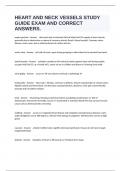Exam (elaborations)
HEART AND NECK VESSELS STUDY GUIDE EXAM AND CORRECT ANSWERS.
- Course
- Institution
angina pectoris - Answer chest pain due to ischemia (lack of blood and O2 supply) of heart muscle, generally due to obstruction or spasm of coronary arteries (heart's blood vessels). Coronary artery disease, main cause, due to atherosclerosis of cardiac arteries aortic valve - Answer left ...
[Show more]



